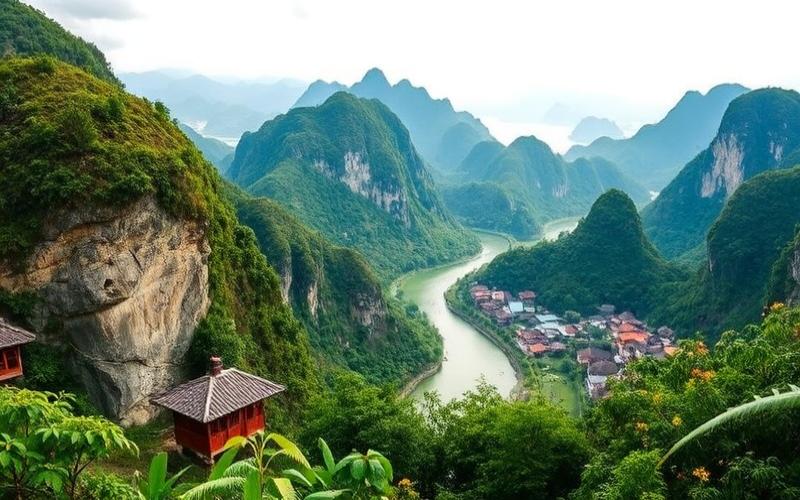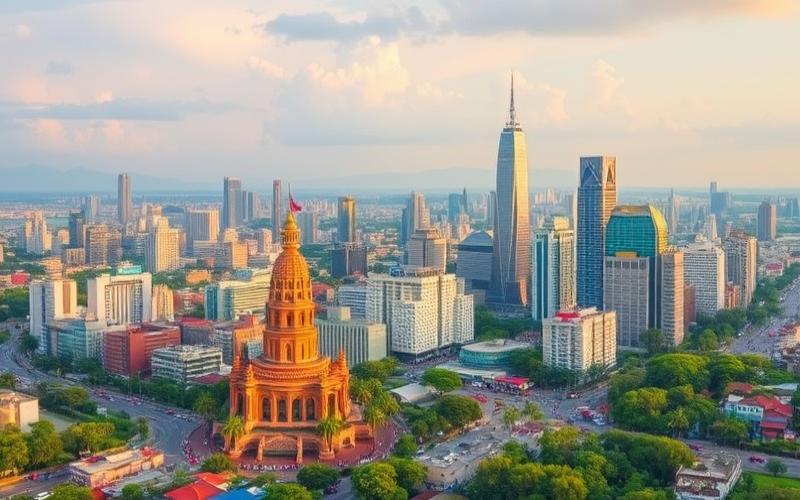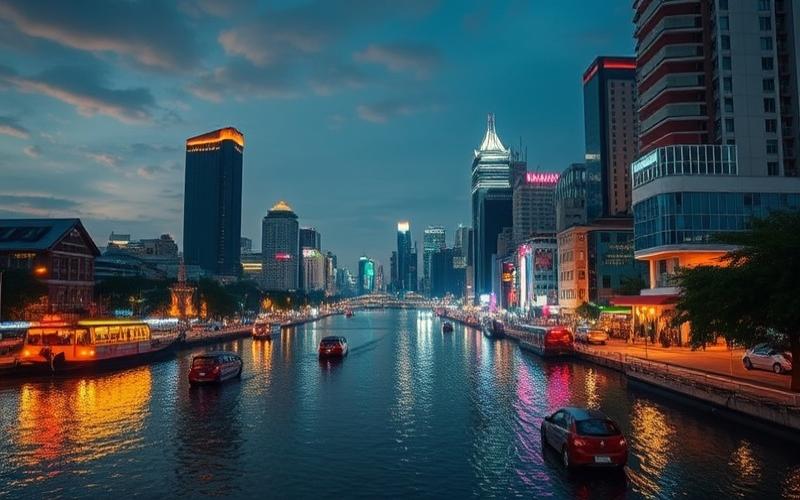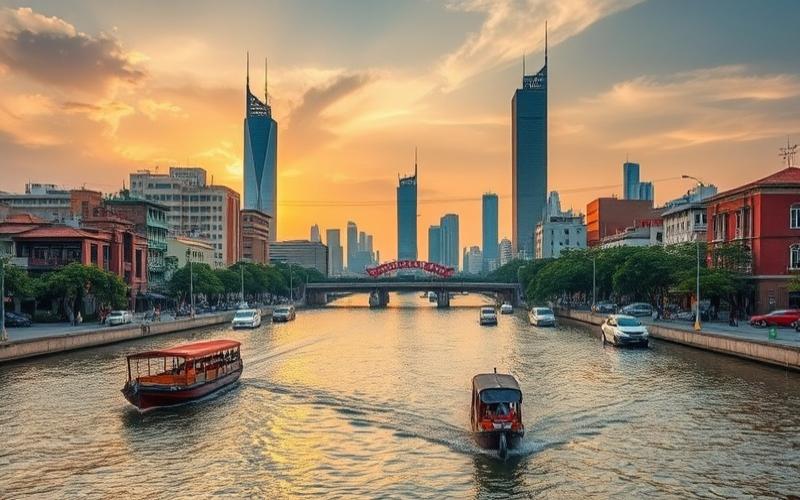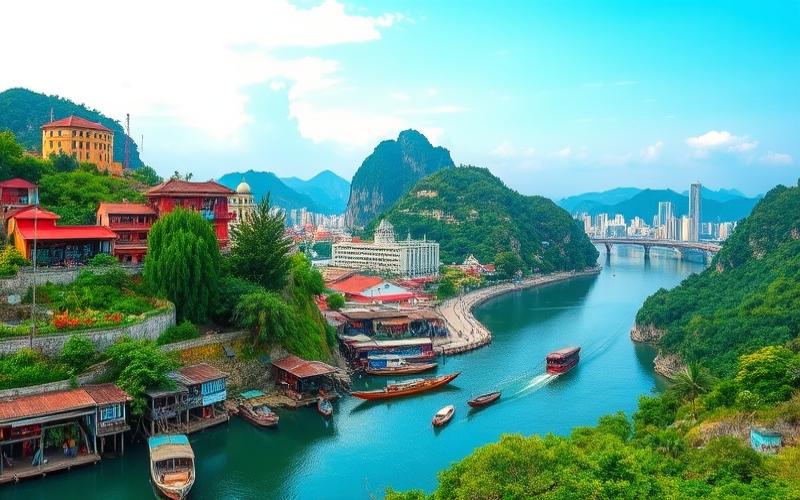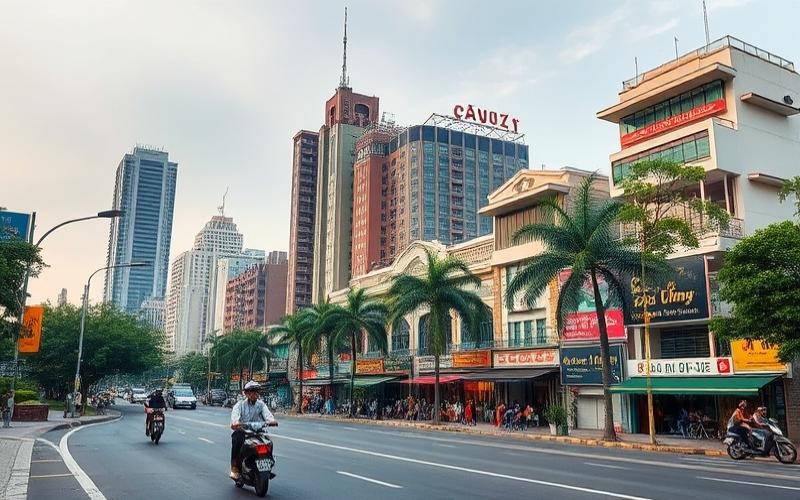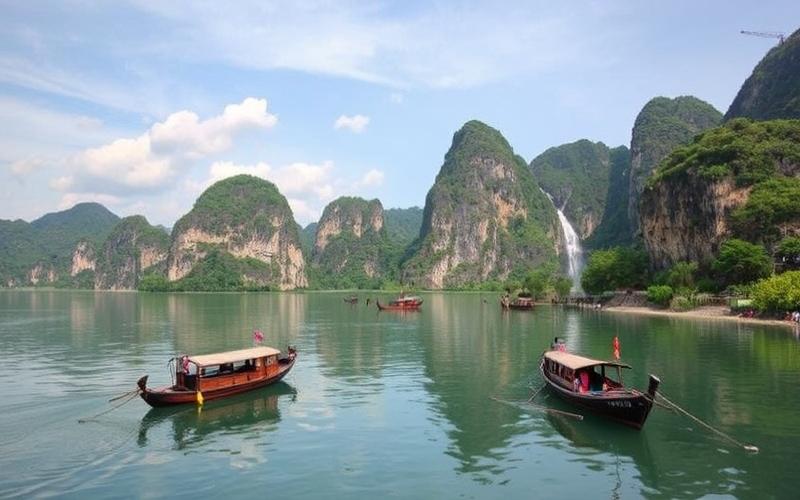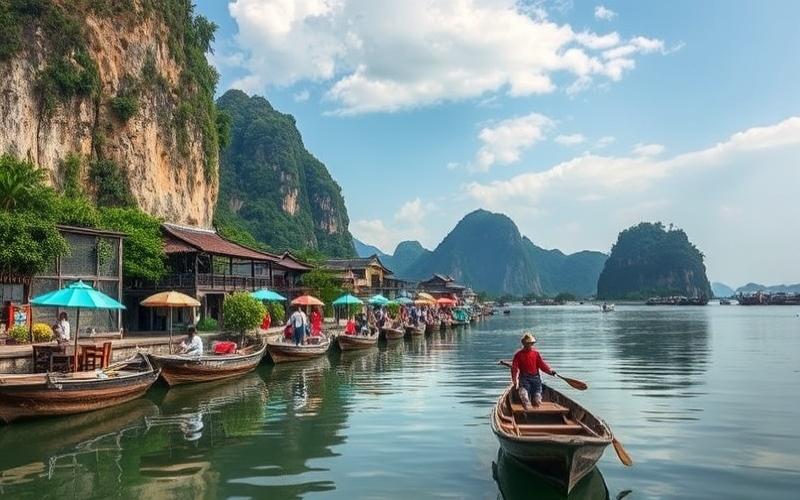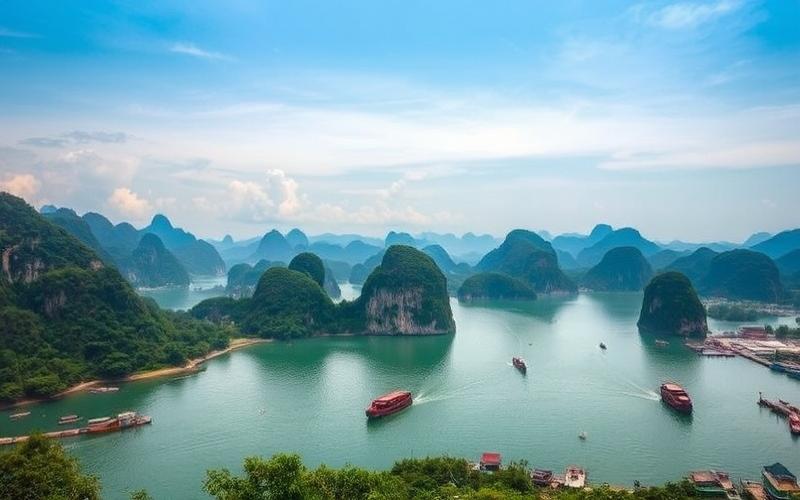
 Published on and written by Cyril Jarnias
Published on and written by Cyril Jarnias
Vietnam’s rapidly growing economy has propelled the country onto the global stage as a prime destination for industry, transforming industrial real estate into an exceptionally promising sector.
At the heart of this dynamic are special economic zones, true engines of economic growth, which offer exceptional tax and logistical advantages to investors. These strategic spaces, benefiting from proactive government support, have become hubs attracting businesses seeking to leverage an ideal geographic position in Southeast Asia.
As Vietnam continues to strengthen its infrastructure and solidify its reputation as an industrial hub, it is crucial to discover which special economic zones stand out and why they represent unmissable opportunities for industrial real estate players.
Opportunities Offered by Logistics Warehouses in Vietnam
Recent Growth of Vietnam’s Logistics Sector and Impact of Foreign Investment
The Vietnamese logistics sector is experiencing rapid growth, with an estimated market value of USD 65 billion in 2024 and an expected growth rate between 14% and 20% for 2025. This momentum is fueled by e-commerce expansion, the diversification of global supply chains, and a massive influx of foreign direct investment (FDI). Foreign companies now dominate the sector, controlling nearly 80% of the total logistics market. Next-generation trade agreements (CPTPP, EVFTA, RCEP) also promote this growth by facilitating access to international markets and stimulating exports.
- Contribution to GDP: approximately 5.17% in 2024.
- Massive investments in logistics technology (WMS, robotic automation).
- Strong demand for modern warehousing linked to the rise of e-commerce.
Vietnam’s Geographic Advantages as a Regional Logistics Hub
Vietnam boasts a strategic position at the heart of Southeast Asia:
- Immediate proximity to China and direct access to major Asian markets.
- Long coastline with deep-sea ports facing international trade routes.
- Membership in several regional networks facilitating redistribution throughout Asia-Pacific.
| Geographic Asset | Description |
|---|---|
| Extensive Coastline | Over 3,200 km with major ports (Hai Phong, Ho Chi Minh City) |
| Proximity to Major Markets | Quick access to China/ASEAN/Japan/Korea |
| Regional Integration | Member of ASEAN+3/RCEP |
Tax Incentives and Other Government Benefits
The Vietnamese government implements attractive measures to encourage warehouse development:
- Partial or total tax exemptions on profits for several years depending on strategic industrial zones.
- Reductions on land use fees for priority logistics projects.
- Streamlined administrative procedures for foreign investment licenses.
Non-exhaustive list:
- Reduced corporate income tax rates in certain special economic zones
- Temporary or permanent VAT exemption on certain imported equipment
Available Infrastructure: Ports, Roads, and Key Industrial Zones
| Infrastructure | Key Location | Specifics |
|---|---|---|
| Seaports | Hai Phong (North), Cat Lai/Ho Chi Minh City | Deep drafts; container capacity |
| Expressways | North-South; urban belts | Direct link to land borders |
| Industrial Zones | Bac Ninh/Binh Duong/Dong Nai | Immediate proximity to port hubs |
Many modern industrial centers are located directly near or integrated with major highway axes connecting seaports/airports/manufacturing zones.
Testimonials & Case Studies: Strategic Choices of International Companies
Several global groups have chosen Vietnam as a regional base:
DHL Supply Chain invested over $150 million in an automated center in Ho Chi Minh City; according to their local executives:
“The unique geographic positioning allows for efficient distribution throughout the ASEAN region while benefiting from local tax incentives.”
Nike/Vans/Foxconn, major suppliers in textiles-electronics, have established their own logistics platforms around Hai Phong/Bac Ninh to “accelerate their time-to-market via privileged access to modern road-port corridors.”
Kuehne+Nagel, the Swiss global leader, recently opened a multi-client hub near Cai Mep-Thi Vai port. They report having reduced their average inter-regional lead times by up to 30% thanks to improved maritime connectivity.
Important Highlight:
Interviewed companies consistently cite three main reasons for their establishment:
- Facilitated access to the Asian regional market
- Competitive tax advantages
- Increasing quality of multimodal infrastructure
Thanks to these combined factors—sustained growth fueled by massive FDI, undeniable geostrategic assets, incentivizing tax policy, and accelerated modernization—Vietnam is now establishing itself as an essential hub for any international player seeking a high-performing logistics base in Asia-Pacific.
Good to Know:
The rapid growth of Vietnam’s logistics sector, supported by foreign investment, offers considerable opportunities with the country positioning itself as a strategic hub in Southeast Asia thanks to its ideal geographic location. Special economic zones benefit from attractive tax incentives and other advantages promulgated by the government to encourage the development of logistics warehouses. Vietnam has robust infrastructure, including numerous seaports, developed road networks, and large industrial zones close to logistics centers. For example, the Japanese company Sumitomo invested in warehouses near Ho Chi Minh City port, citing the favorable combination of tax conditions, Vietnam’s centrality for serving the Asian market, and the modernity of infrastructure as main reasons for their expansion.
Special Economic Zones in Vietnam: A Lever for Investor Attractiveness
Special economic zones in Vietnam play a central role in the country’s attractiveness for foreign investors. They mainly fall into two categories:
- Industrial Parks (including export processing zones, eco-industrial, high-tech, auxiliary zones)
- Special Economic Zones (coastal or border areas)
These zones benefit from precise legal frameworks under the Investment Law and are managed by the Ministry of Planning and Investment.
Main Characteristics of Vietnamese Special Economic Zones:
- Modern infrastructure adapted for industrial production and logistics
- Strategic location near major urban centers or key port axes
- Abundant and competitive workforce
- Efficient logistics network facilitating import/export
Tax Advantages Offered to Investors:
| Tax Advantage | Description |
|---|---|
| Tax Exemption | Full corporate income tax exemption for several years |
| Reduced Rate | Reduced tax rate after the initial period |
| Favorable VAT | Reduction or even exemption of VAT for certain operations |
| Customs Duties | Exemptions on imports of raw materials/equipment |
Administrative Facilities:
- Simplified procedures for business creation, quick license issuance
- Centralized administrative services (“one-stop shop”)
- Facilitated access to public services (electricity, water, telecommunications)
Positive Impact on Economic and Industrial Real Estate Development:
- Special economic zones serve as dynamic hubs attracting foreign direct investment (FDI), technology transfers, and massive job creation.
- They stimulate the rapid development of the industrial real estate sector: multiplication of modern warehouses, turnkey factories, logistics platforms.
Specific Examples:
| Special Economic Zone | Location | Specifics/Main Assets |
|---|---|---|
| Saigon Hi-Tech Park | Ho Chi Minh City | High-tech hub with multinationals (Samsung…), port proximity |
| VSIP Bac Ninh Industrial Park | Bac Ninh | Manufacturing hub connected to Hanoi & major road axes |
| Da Nang Pilot Free Trade Zone | Da Nang | Adjacent to Lien Chieu seaport; mix of production/logistics/services/tourism |
The Da Nang Pilot Free Trade Zone, for example, plans a progressive extension up to 2,500 hectares by 2050 with an organization into specialized sub-zones: industrial production, advanced logistics connected to Lien Chieu international port, commerce/digital innovation, or tourism activities. This diversity promotes optimal integration into global chains.
Strategic Assets for International Trade:
- Immediate proximity to international seaports (Ho Chi Minh City – Cat Lai; Hai Phong; Da Nang)
- Highway connections to ASEAN/China facilitating fast export/import
- Integrated multimodal platforms
Future Perspectives:
With Vietnam’s industrial upgrading and increased participation in regional/global trade agreements (CPTPP, RCEP, etc.), special economic zones are expected to continue developing as key drivers of national economic dynamism. Global trends such as partial relocation (“China+1”), industrial automation, or the transition to a digital economy reinforce their attractiveness to investors seeking regulatory stability and competitive costs.
Key Takeaways:
Vietnamese special economic zones constitute a decisive lever for attracting international capital thanks to their attractive tax environment,
their simplified procedures,
their privileged access to strategic infrastructure,
and their proven ability to energize both the manufacturing sector and industrial real estate.
Good to Know:
Special economic zones in Vietnam, such as those in Ho Chi Minh City, Da Nang, and Bac Ninh, are hubs of attraction for foreign investors thanks to their numerous economic and infrastructural advantages. These zones offer tax incentives, such as profit tax exemptions and tariff reductions, complemented by simplified administrative procedures for business registration. Their strategic geographic location optimizes international trade exchanges, particularly with neighboring Asian markets. The Ho Chi Minh City special economic zone, for example, is a nerve center for technology industries, thereby facilitating the import-export of electronic products. This configuration stimulates local economic development and energizes industrial real estate, making these zones particularly attractive to multinationals seeking to expand their presence in Southeast Asia. With sustained economic growth and increasing investment flows in the region, these special economic zones are well-positioned to continue prospering and attracting more investment in the coming years.
Analyzing Industrial Real Estate Yields in Vietnam
Industrial real estate yields in Vietnam are experiencing an upward trend in 2024 and 2025, driven by strong demand, a massive influx of foreign direct investment (FDI), and favorable public policies. Occupancy rates remain high, indicating supply tension, while short and long-term prospects are particularly optimistic.
Recent Statistics and Trends
- Industrial zone occupancy rates:
- Northern Vietnam: 80%
- Southern Vietnam: 89%
- Industrial production index (first half of 2025): +9.2% year-on-year
- Registered FDI (first half of 2025): $21.52 billion (+32.6%)
- Disbursed FDI (first half of 2025): $11.72 billion (5-year record)
- Over 400 planned industrial zones, approximately 300 in operation
| Region | Occupancy Rate (%) | Main Attractive Provinces | Recent Dynamics |
|---|---|---|---|
| North | 80 | Bac Ninh, Hai Phong, Hanoi | New zones, electronics and electric vehicle transactions |
| South | 89 | Binh Duong, Dong Nai, Long An, Ba Ria-Vung Tau | Strong absorption, supply diversification, infrastructure investments |
Economic and Logistical Factors Influencing Yields
- National industrial growth: The rise in manufacturing production, particularly in electronics and automobiles, stimulates demand for industrial space.
- Growing FDI: Vietnam is attracting more and more multinationals seeking to diversify their supply chains outside of China, especially to benefit from free trade agreements.
- Infrastructure improvement: Major logistics infrastructure and transport projects (roads, ports, modern industrial parks) that increase regional competitiveness.
- Government policies: Tax reforms, administrative facilitation, and tax incentives for foreign investors.
Regional and Seasonal Variations
- Regional:
- The South shows higher occupancy rates, driven by industrial density and proximity to international ports.
- The North benefits from strong demand in electronics and automobiles, with new real estate projects.
- Seasonal:
- Stronger space absorption in the first quarter, ahead of international trade policy announcements.
- Demand may slow during major regulatory or tax adjustments, but the trend remains upward.
Regional Comparisons (ASEAN)
| Country | Industrial Zone Occupancy Rate | Industrial Rent Growth | Industrial Real Estate Yields |
|---|---|---|---|
| Vietnam | 80-89% | Strong (+) | 7-9% (estimated) |
| Thailand | 70-75% | Moderate | 6-8% |
| Indonesia | 75-80% | Stable | 6-7% |
| Malaysia | 70-80% | Low | 5-6% |
Growth Prospects
- Short term (2025):
- Expected increase in industrial rents, supported by demand and supply struggling to keep up.
- New industrial zones under development, particularly in secondary provinces.
- Long term (2025-2030):
- Maintenance of Vietnam as a key destination for industrial relocation in Southeast Asia.
- Diversification of sectors (high technology, advanced logistics, green automobiles).
- Continued investment in logistics infrastructure and regional connectivity.
Impacts of Government Policies
- Favorable investment reforms: simplified procedures, tax incentives, improved transparency.
- Development of strategic industrial zones, with modernized infrastructure to attract international investors.
- Rapid adaptation to global trade evolutions (e.g., adjustments in response to US tariffs).
Effects of Foreign Investments
- FDI boosts demand, raises quality standards, and accelerates the professionalization of the sector.
- Foreign investors promote the emergence of new industrial hubs and stimulate logistics and technological innovation.
- International competition for access to the best industrial zones contributes to rising rents and yields.
| Key Takeaway |
| Vietnam is positioning itself as one of the most dynamic industrial markets in Southeast Asia, with high yields, growth supported by FDI, and very favorable prospects for the coming years. |
Good to Know:
Industrial real estate yields in Vietnam are on the rise, supported by increasing foreign investment and the growth of special economic zones, which benefit from favorable government policies. In 2023, the average occupancy rate of industrial parks reached 90%, with higher yields in southern regions like Ho Chi Minh City due to advanced logistics infrastructure. Comparatively, yields in Vietnam are competitive with neighboring countries like Thailand, attracting more and more companies seeking to relocate in response to global economic disruptions. Performance, however, varies regionally, influenced by seasonal fluctuations in agricultural demand, as well as government initiatives aimed at improving the north-south transport network, promoting sustained growth in the coming years.
Disclaimer: The information provided on this website is for informational purposes only and does not constitute financial, legal, or professional advice. We encourage you to consult qualified experts before making any investment, real estate, or expatriation decisions. Although we strive to maintain up-to-date and accurate information, we do not guarantee the completeness, accuracy, or timeliness of the proposed content. As investment and expatriation involve risks, we disclaim any liability for potential losses or damages arising from the use of this site. Your use of this site confirms your acceptance of these terms and your understanding of the associated risks.




